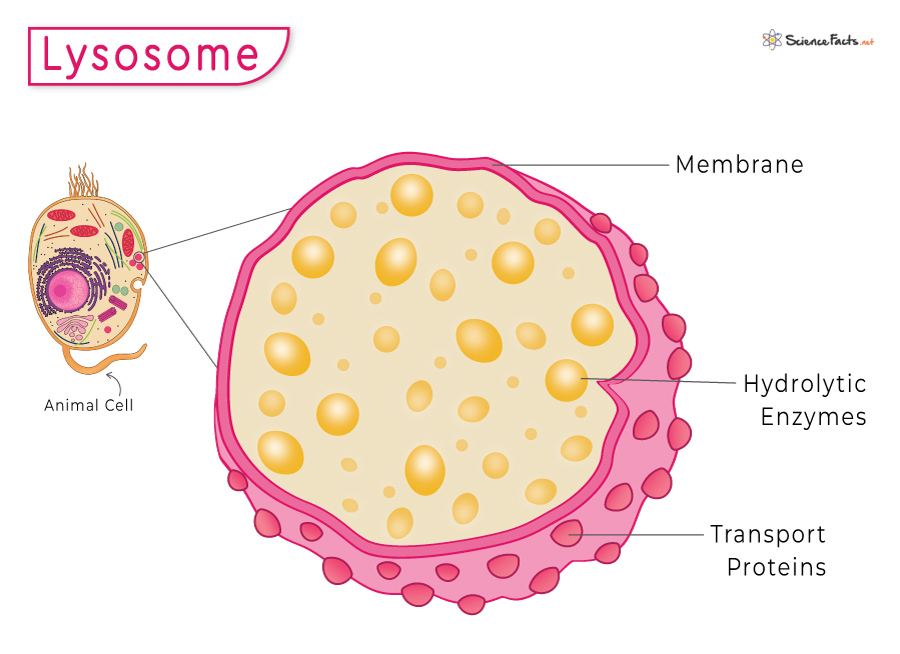When activated, they function as the cell’s digestive system that destroys invading viruses and bacteria, repairs worn-out cells, and in programmed cell death or apoptosis. If lysosomes are absent in a cell, the cells tend to gather these substances and become poisonous. They are hence called the ‘trash can’ or the ‘recycle bin’ of the cell and are essential to maintain the health of a cell. Do Plant Cells Have Lysosomes Although predominantly found in animal cells, recent discoveries show that the function of vacuoles in plant cells is similar to the lysosomes in animal cells. How Many Lysosomes are in a Cell There are 50 to 1,000 lysosomes in a typical mammalian cell. However, plants and fungi have a single large or multilobed vacuole.
Lysosome Structure
Why are Lysosomes Called Suicidal Bags
How are Lysosome Formed
Lysosome Functions
Lysosomal Diseases
The lysosome membrane comprises a lipid bilayer similar to a cell membrane containing hydrophilic phosphate group heads, a glycerol molecule, and hydrophobic fatty acid tails. The pH of the lumen lies between 4.5 and 5.0 and thus is acidic. It is similar to the pH of the acids found in the stomach. Lysosomes are formed by the union of transport vesicles that bud off from the trans-Golgi apparatus as sacs or vesicles with endosomes, which contain molecules taken up by endocytosis at the plasma membrane. The hydrolytic enzymes within the lysosome are formed in the endoplasmic reticulum.
1. Digestion of Macromolecules
One of the significant purposes of the lysosome is the digestion of foreign molecules taken up inside the cell by endocytosis. Lysosomes contain about 50 hydrolyzing enzymes that digest macromolecules (nucleic acid, proteins, carbohydrates, and lipids) by hydrolysis. Nucleic acids are broken down into nucleotides by nucleases, proteins into amino acids by peptidases, carbohydrates into simple sugars by amylases, and lipids into fatty acids and glycerol by lipases. These processes release energy that the cell requires for performing various cellular activities. These recycled monomers are also used to synthesize macromolecules when needed by the cell or are released outside the cell as waste products.
2. Intracellular Transport by Endocytosis
As a part of the endomembrane system, the lysosome, Golgi apparatus, and endoplasmic reticulum exchange and digest materials within and outside the cell. The lysosome also maintains the cell’s internal milieu. The steps are:
3. Phagocytosis and Autophagy
Apart from degrading the foreign molecules by endocytosis, digesting materials through phagocytosis and autophagy helps to protect the cell from large particle invasions such as pathogens and remove aged cells and cell debris. In phagocytosis, specialized antigen-presenting cells like macrophages take up and degrade large molecules that need immediate removal from the body. Such molecules are taken up in phagocytic vacuoles known as phagosomes which then fuse with lysosomes, resulting in the digestion of the particle. The lysosome helping in such digestion is called phagolysosome. Lysosomes are also involved in autophagy, a process by which cells destroy old, abnormal, or damaged proteins and other substances in their cytoplasm that helps recycle cellular components in an organism. Besides the above functions, lysosomes are also involved in various cellular processes such as secretion, plasma membrane repair, apoptosis, cell signaling, and energy metabolism.
4. Platform for Intracellular Signal Transduction
Lysosomes can sense nutrients and thus regulate cell proliferation and growth with the help of signaling cascades like PI3K/AKT by activating receptor tyrosine kinases (RTKs) and epidermal growth factor receptors (EGFRs), among others. Most of these diseases occur due to deficiencies in single lysosomal enzymes. For example, Gaucher’s disease, the most common LSD, results from a gene mutation that encodes for an enzyme required to break down glycolipids.
